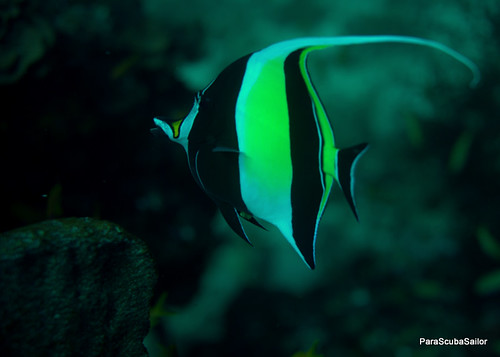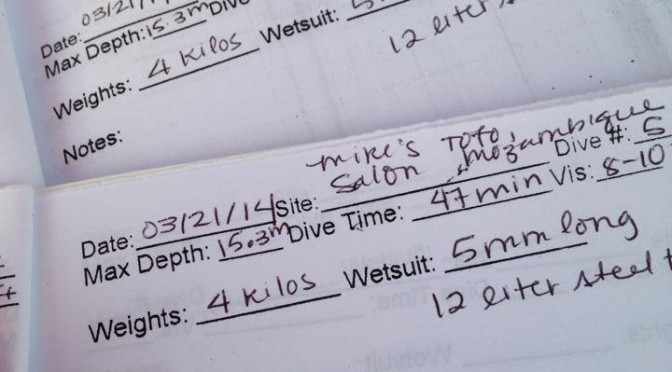Since we arrived in Tofo on Monday, we had done nothing but laze about and frolic in the Indian Ocean. We figured that it was high time we did something with ourselves, and so we signed up for a SCUBA review course with Peri-Peri Divers.
We first tried diving in Thailand during our bar trip in the summer of 2008. We did an adventure dive off the coast of Koh Pha Nagn, and we had an amazing time. So amazing, in fact, that we got open water certified in Honduras in early 2010.1
We had packed our PADI cards and our dive log books (neither of which had seen the light of day since we completed the open water certification four years ago), and figured that Tofo – which our guidebook tells us is the unofficial diving capital of Mozambique – was the perfect place to put them to use.
We met our dive master Frida, a friendly Scandanavian woman with an apparent affinity for the color pink, at 8:30 this morning,2 and she wasted no time in administering a quiz. This was, after all, the reason that we had signed up for the SCUBA review course rather than doing an adventure dive: we wanted the chance to review how much dive knowledge we had retained (or lost) and to brush up on our skills.

After we finished the quiz (on which we both performed admirably), reviewed the Recreational Dive Planner3 with us, and practiced setting up our kits, we moved on to the pool to practice our skills. Going under in the pool was at once both familiar and strange.
I was particularly apprehensive about my least favorite skill: removing your mask under water and then replacing it. This was the skill that had nearly cost me my open water certification (and, if I’m feeling dramatic, my life) back in 2010. It was our second-to-last round of skill practice, which we were practicing in the open water. I removed my mask, replaced it, cleared it, and got the okay sign from our instructor, who then moved on to watch Marc perform the skill. Apparently, however, I hadn’t cleared the mask well enough, and some water got into my nose. This caused me to cough, and, in so doing, I spit out the regulator and promptly inhaled a mouthful of salt water. It was probably only seconds before the instructor swam over and replaced my regulator (and then I did a controlled ascent to the surface to finish coughing up the water), but it felt like hours, and I wasn’t relishing the opportunity to face that skill again.
When it was my turn to practice that skill in the pool today, I had trouble psyching myself up. Frida showed me a different way of removing and replacing the mask (less time with my nose exposed, and less hair pulling!), and it made all the difference. We semi-breezed through the rest of the skills (I’m awarding myself an “E” for “Effort” in removing my BCD underwater, and nothing more), and then took a short lunch break before we headed off for our real dive.
The group heading out for the dive to a site named Mike’s Cupboard (although we ended up at the Salon) consisted of us, Frida, another dive master (a French girl named Emme), a Finnish couple, another couple of indeterminate origin, and a woman who joined us on the beach, bearing a fancy underwater camera the size of a cocker spaniel and not much else.4 We were far and away the most inexperienced divers on the trip, but everyone couldn’t have been friendlier to us.

The boat that took us to the dive site was basically a boat-shaped motorized inflatable raft. It took all of us – plus a few more people – to shove the boat off the beach and into the water, and the boat careened over waves as it made its way out to the dive site.
Once we reached the site, Frida had us try a negative entry, which is basically rolling off the boat backwards without your BCD inflated so you immediately go straight down. We didn’t prove to be very successful in that skill, ending up floating on the surface more than everyone else, but we managed to follow the rope down and join them on the bottom.
Once on the bottom, we basically just swam around a reef and looked at whatever we wanted to look at. We saw tons of different types of brightly colored fish, as well as rays, eels, shrimp, crabs, and an octopus. The dive was deeper and longer than any of our previous dives, hitting a maximum depth of 15.3 meters and lasting 47 minutes.
Well, it lasted 47 minutes for us. My air tank hit 50 bars first (I guess I’m just a deep breather?), and so Emme led Marc and I up to the surface. The boat retrieved us (and gave us delicious suckers with fizzy centers), and then Emme rejoined the other divers for another few minutes until everyone was ready to come back up.
The dive was amazing but it was also physically taxing, and, by the time we were back on shore, had broken down and put away our kits, and settled up at the SCUBA shop, we were exhausted. Frida suggested we try some additional shallow dives while we’re still in Tofo, but just thinking about diving tomorrow makes me tired. But while we may not dive again this weekend, it’s certainly not going to be four more years before we dive again!
1 The trip to Honduras was sort of our second bar trip. We left the day after I had taken the New York bar exam.
2 It was an early morning considering a storm came through in the middle of the night and rained through the roof of our cabin, through our mosquito netting, and right onto our heads.
3 This table helps you calculate how long you can stay in the water at what depth, and how long before you can go in the water again.
4 You’ll note that I have no awesome first-hand pictures on this post. That’s because, not only do I not have a pet-sized camera, I don’t have an underwater camera. Sorry! Enjoy the Flickr pics of types of fish we actually saw.



Martha said to tell you she is impressed with your diving skills; we, alas, are only working on our driving skills. We get to practice a lot today as we have an 11-1/2 hour drive.
Hope the drive went well! xo
I am so impressed with your SCUBA skills! I could barely readjust my mask while snorkeling!
Definitely most improved from the Isla de Mujeres booze cruise snorkel trip in 2006!